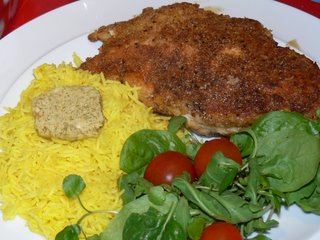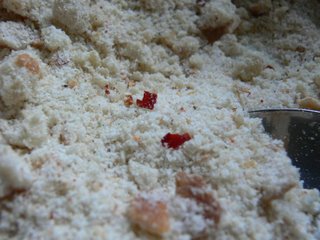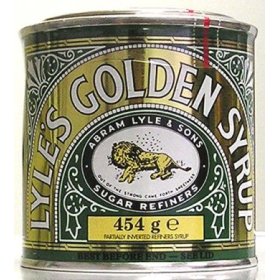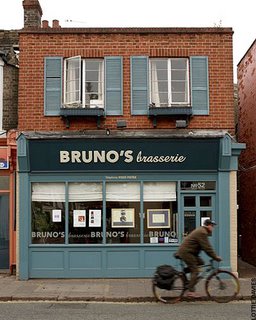 This is a rather special Chicken Kiev. It has a super-crisp coating and is bursting with a garlic butter full of extra flavours. (You will notice that I am overdosing a little on saffron rice at the moment. It’s lovely with chicken dishes – just cook your rice as usual, but add a large pinch of saffron, which you’ve soaked in an eggcup of water from the kettle for twenty minutes, with the rest of the cooking water.)
This is a rather special Chicken Kiev. It has a super-crisp coating and is bursting with a garlic butter full of extra flavours. (You will notice that I am overdosing a little on saffron rice at the moment. It’s lovely with chicken dishes – just cook your rice as usual, but add a large pinch of saffron, which you’ve soaked in an eggcup of water from the kettle for twenty minutes, with the rest of the cooking water.)
The flavoured butter carefully packed inside this chicken (and balancing cheekily on top of that lovely saffron rice) is worth making in bulk and keeping in the freezer. You can slice it direct from the frozen roll and use it to melt over steaks, to baste roast chickens, to flavour couscous, to fill a baked potato, and anywhere you need rich flavour and lovely moist butteryness. If roasting the garlic for the butter is just too much faff for you, use an extra three cloves of raw garlic instead.
Use the largest chicken breasts you can find for this recipe; this will make it much easier to keep the pool of butter inside the bird until you cut it on your plate. Waitrose is currently selling a chicken called the Poulet d’Or – a massive and delicious behemoth of a bird which grows slowly (and ethically, at Leckford Farm, an enterprise owned by Waitrose’s parent company) – it’s fed an organic, corn-rich diet, allowed to forage and roam free, and is slaughtered at around 90 days rather than the usual four weeks. It’s a big bird, but it’s tender and extremely flavourful – I’ve read comparisons to Poulet de Bresse, and for special occasions I will be very happy to spend the £12 again on two breasts. (A whole bird comes in at about twice that price, but I’d estimate that it would very happily feed six people, so the effective price is high but not unreasonable.)
To make half a pound of garlic and herb butter, and two Chicken Kievs, you’ll need:
Garlic and herb butter
1 pat of good, salted butter (2 sticks in America), plus a tablespoon of butter to roast the garlic
1 head of garlic (to roast)
3 cloves of garlic (to be kept raw)
2 bay leaves
1 large sprig thyme
1 tablespoon chopped fresh tarragon
1 tablespoon chopped fresh chervil (leave this out if you can’t find any)
1 tablespoon chopped fresh parsley
1 fresh red chilli
½ teaspoon paprika
Juice and zest of 1 lemon
1 tablespoon light soya sauce
Large pinch of salt
Chicken
2 large chicken breasts, skinned and boned
Crumbs from two slices of white bread (blend in a food processor to make crumbs)
An equal volume of polenta or cornmeal
5 tablespoons grated parmesan
4 extra tablespoons polenta or cornmeal
2 eggs, beaten
Salt and pepper
1 teaspoon chilli flakes
Start by roasting the garlic for the butter. Slice the bulb of garlic in half across its equator and put the tablespoon of butter, the bay leaves and the thyme on the cut side of the bottom half, seasoning generously. Place the top half of the garlic bulb on top, making a herby sandwich. Roast at 180° C for 40 minutes. Remove from the oven and cool.
Pop the soft, roast cloves of garlic out into the food processor, and add the raw garlic; the tarragon, parsley, chervil and basil; the chilli and paprika; the lemon zest and juice; and the soya sauce. Drop in the half pound of butter and blend until everything is amalgamated and finely chopped into the butter.
Make a long sausage of the flavoured butter on a piece of tin foil. Wrap tightly and place in the freezer for at least an hour.
 When the butter has chilled, start on the chicken. Begin by combining the breadcrumbs and an equal volume of polenta in one bowl with the parmesan and chilli flakes. Put the four tablespoons of polenta in a separate bowl, and beat the eggs in a final bowl.
When the butter has chilled, start on the chicken. Begin by combining the breadcrumbs and an equal volume of polenta in one bowl with the parmesan and chilli flakes. Put the four tablespoons of polenta in a separate bowl, and beat the eggs in a final bowl.
Take your smallest knife. Sharpen it vigorously. Use it to make a slit down the side of one chicken breast, creating a pocket inside the muscle. Be very careful not to cut all the way through. Remove the little fillet strip from underneath the breast and set it to one side.
Slice a disc of butter from the frozen butter sausage and tuck it inside the pocket. You may be able to fit more than one disc in, but be careful not to overstuff the breast, or the butter will leak out in cooking. If the butter sticks out at all, just trim it carefully so it’s firmly inside the meaty pocket.
Dip the fillet strip in the polenta, then back in the egg. Dip the chicken breast in the polenta, then the egg, and sprinkle the area where the slit is with a bit of extra polenta. Use the polenta and egg to glue the fillet strip around the slit. Roll the whole sticky assembly in the breadcrumbs mixture, patting plenty on around the slit/fillet area to make a good seal and ensuring everything is covered well. Repeat the process with the other breast.
Heat two tablespoons of butter and two of olive oil in a heavy, large frying pan. Bring the pan to a high temperature and carefully slide the chicken pieces in, slit/fillet area facing down. Turn the heat down to just below medium and leave the chicken breasts for 15 minutes, without poking or moving. After 15 minutes, flip them over (the bottoms will have turned an amazing golden crisp) and leave for another 15 minutes. Serve immediately. The melted butter will have formed a delicious pool inside the chicken breasts, and will pool out when you slice into the meat with your knife. Make sure you have plenty of rice to soak it all up.


